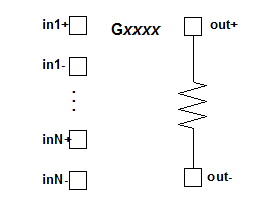|
微波射频仿真设计 |
|
|
微波射频仿真设计 |
|
| 首页 >> Ansoft Designer >> Ansoft Designer在线帮助文档 |
|
Nexxim Simulator > Voltage-Controlled Resistor, Polynomial

Polynomial VCR Netlist FormatThe format for a polynomial voltage-controlled resistor (VCR) is: Gxxxx out+ out- VCR POLY(N) in1+ in1- [in2+ in2- [in3+ in3-]] [MAX=val] [MIN=val] [SCALE=scale] [M=val] [TC1=val] [TC2=val] p0 [p1 ... pK ] out+ is the positive node and out- is the negative node of the resistor. The entry VCR is required to select the voltage-controlled resistor type. The entry POLY is required to identify the polynomial VCR. The number of input voltage pairs, N, can be 1, 2, or 3. If N is not specified, 1 input is the default. in+ and in- are the N pairs of positive and negative nodes for the control voltages. p0 through pK are the K coefficients for the polynomial function. One coefficient must be provided.
Polynomial VCR Netlist ExamplesG21 21 0 VCR POLY(1) 1 0 1.1 2.1 0 3.1 G31 31 0 VCR POLY(2) 1 0 2 0 1.2 2.2 0 0 0 0 0 0 3.2 0 G41 41 0 VCR POLY(3) 1 0 2 0 3 0 1.3 2.3 0 0 + 0 0 0 0 0 0 + 0 3.3 0 0 0 0 0 0 0 4.3
NotesThe functional equation for the polynomial VCR is: R(out+, out-)) = [polynomial ´ SCALE ´ (1 + DT ´ TC1 + DT2 ´ TC2)] / M If the result is less than MIN, R(out+, out-) = MIN If the result is greater than MAX, R(out+, out-) = MAX The polynomial depends on the number of inputs (N) and the number of polynomial coefficients (K). Each polynomial has terms of order (O), the sum of the exponents of the elements in the term. The list of coefficients must include coefficients for every term up to and including the complete group of terms with the highest order in the specified polynomial, using zero coefficients for any intermediate or trailing terms that are not to be computed. When N=1, the polynomial formula has one term each of order O{0, 1, ... K}: p0 + p1 ´ V(in1+, in1-) + ... pK ´ V(in1+, in1-)K Each coefficient must be a real value or zero to represent a missing term. For example, to specify a VCR between nodes 21 and 0 whose output, controlled by the voltage across nodes 1 and 0, is described by the one-input polynomial 1.1 + 2.1 ´ V(1, 0) + 3.1 ´ V(1, 0)3, the instance statement would set coefficients p0=1.1, p1=2.1, p2=0, and p3=3.1: G21 21 0 VCR POLY(1) 1 0 1.1 2.1 0 3.1 When N=2, the polynomial formula can have more than one term in each order grouping: O(0) p0 + O(1) p1 ´ V(in1+, in1-) + p2 ´ V(in2+, in2-) + O(2) p3 ´ V(in1+, in1-)2 + p4 ´ V(in1+, in1-) ´ V(in2+, in2-) + p5 ´ V(in2+, in2-)2 + O(3) p6 ´ V(in1+, in1-)3 + p7 ´ V(in1+, in1-)2 ´ V(in2+, in2-) + p8 ´ V(in1+, in1-) ´ V(in2+, in2-)2 + p9 ´ V(in2+, in2-)3 + O(4) ... For example, to specify a VCR between nodes 31 and 0 whose output, controlleed by the voltages across node pairs (1, 0) and (2, 0), is described by the two-input polynomial 1.2 + 2.2 ´ V(1, 0) + 3.2 ´ V(1, 0) ´ V(2, 0)2, the instance statement would set coefficients p0=1.2, p1=22, and p8=3.2. Intermediate coefficients p2 through p7 and trailing coefficient p9 are set to 0: G31 31 0 VCR POLY(2) 1 0 2 0 1.2 2.2 0 0 0 0 0 0 3.2 0 When N=3, the polynomial formula becomes: O(0) p0 + O(1) p1 ´ V(in1+, in1-) + p2 ´ V(in2+, in2-) + p3 ´ V(in3+, in3-) + O(2) p4 ´ V(in1+, in1-)2 + p5 ´ V(in1+, in1-) ´ V(in2+, in2-) + p6 ´ V(in1+, in1-) ´ V(in3+, in3-) + p7 ´ V(in2+, in2-)2 + p8 ´ V(in2+, in2-) ´ V(in3+, in3-) + p9 ´ V(in3+, in3-)2 + O(3) p10 ´ V(in1+, in1-)3 + p11 ´ V(in1+, in1-)2 ´ V(in2+, in2-) + p12 ´ V(in1+, in1-)2 ´ V(in3+, in3-) + p13 ´ V(in1+, in1-) ´ V(in2+, in2-)2 + p14 ´ V(in1+, in1-) ´ V(in2+, in2-) ´ V(in3+, in3-) + p15 ´ V(in1+, in1-) ´ V(in3+, in3-)2 + p16 ´ V(in2+, in2-)3 + p17 ´ V(in2+, in2-)2 ´ V(in3+, in3-) + p18 ´ V(in2+, in2-) ´ V(in3+, in3-)2 + p19 ´ V(in3+, in3-)3 + O(4) ... For example, to specify a VCR between nodes 41 and 0 whose output, controlled by voltages across node pairs (1, 0), (2, 0), and (3, 0), is described by the three-input polynomial 1.3 + 2.3 ´ V(1, 0) + 3.3 ´ V(1, 0)2 ´ V(2, 0) + 4.3 ´ V(3, 0)3, the instance statement would set coefficients p0=1.3, p1=2.3, p11=3.3, and p19=4.3. Intermediate coefficients p2 through p10 and p12 through p18 are set to 0 (since p19 is the coefficient for the highest term with order 3, no trailing zeros are needed): G41 41 0 VCR POLY(3) 1 0 2 0 3 0 1.3 2.3 0 0 + 0 0 0 0 0 0 + 0 3.3 0 0 0 0 0 0 0 4.3 HFSS视频教程 ADS视频教程 CST视频教程 Ansoft Designer 中文教程 |
|
Copyright © 2006 - 2013 微波EDA网, All Rights Reserved 业务联系:mweda@163.com |
|